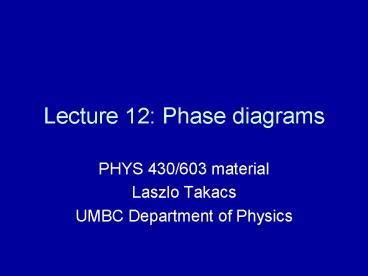Lecture 12: Phase diagrams PowerPoint PPT Presentation
Title: Lecture 12: Phase diagrams
1
Lecture 12 Phase diagrams
- PHYS 430/603 material
- Laszlo Takacs
- UMBC Department of Physics
2
Phases and the phase rule
- Phase Uniform agglomeration of material - no
boundaries inside - Gibbs phase rule f n - p 2
- f degrees of freedom, i.e. number of freely
selectable thermodynamic parameters. Typically
temperature, pressure, concentrations. - n number of chemical components.
- p number of phases in equilibrium
- When phases are in equilibrium, atoms of any
component can be transferred between phases.
Equilibrium requires equal chemical potentials,
mathematically equations that reduce the number
of freely selectable parameters.
3
The phase diagram of UF6 as a function of p and
T n 1, thus f 3 - p
4
Pressure-temperature phase diagram of single
component systems sulfur and silicon dioxide.n
1, thus f 3 - p
5
The T-p phase diagram of FeUsually processes
are carried out at atmospheric pressure, thus we
will usually neglect the pressure dependence.
Extreme high pressure does cause phase changes.
6
- n 2, thus f 4 - p
- The phase diagram of a two-component system is
usually shown for a fixed - ambient - pressure.
The remaining variables are temperature and the
concentration of either component. Notice - allotropic phases (Ti),
- solid solutions,
- compound phases,
- two-phase regions,
- transformations,
- etc.
7
The lever rule on the amount of each phase in a
two-phase region
- Sample is 1 mole total, contains
- (1 - c) mole of component A
- c mole of component B
- We can also consider the sample as
- m? mole of phase ? with c? plus
- m? mole of phase ? with c?
- Total of component A in the sample
- 1 - c m? (1 - c?) m? (1 - c?)
- Total of component B in the sample
- c m? c? m? c?
- The sum of these two equations gives
- 1 m? m? as it should be.
- From the last two equations we get
- m? (c? - c) / (c? - c?)
- m? (c - c?) / (c? - c?)
- m? / m? (c? - c) / (c - c?)
?
?
c? c c?
c cB
A
B
Notice that c? is not the same as cA, even if
phase ? is a solid solution based on A.
8
What determines the phase diagram?
- Equilibrium is given by the minimum of the Gibbs
potential, G. If more than one phase are
possible, the phase with the lowest G is the
equilibrium state. - G H - TS At low temperature enthalpy dominates.
- Entropy becomes increasingly important at
higher T. - Ideal solution Two chemically similar components
- G H - T (Sv SM) GM - TSM
- Assume
- GM changes linearly from A to B.
- Configurational entropy SM -Nk c ln c (1-c)
ln (1-c) - (same idea as with vacancies)
- The slope of SM goes to /- 8 when c --gt 0 or 1
9
G(T,c) of an ideal solution
- GM is a simple weighted average of the Gibbs
potential of the components and ?Sm is the
configurational entropy. - Notice that the entropy term becomes more
important with increasing temperature, increasing
the curvature of the G(c) curve.
10
- Comparing G for the ideal solution and the
similar G for the liquid phase allows the
construction of a hypothetical phase diagram. - Notice that S is lower for low, L is lower for
high temperature. - Notice the changing curvature.
- In intermediate states, neither L nor S gives the
smallest possible G. The state is a mixture of
the two common tangent gives the concentrations,
the lever rule gives the relative amounts.
11
Why the common tangent?
- For an average concentration of c, we have x
fraction with c1 and (1 - x) with c2. - c x c1 (1 - x) c2, thus
- x (c2 - c) / (c2 - c1) 1 - x (c - c1) / (c2
- c1) - The Gibbs potential for the mixture
- G G1 x G2 (1 - x)
- G1 (c2 - c) / (c2 - c1) G2 (c - c1) / (c2
- c1) - This is a linear equation that describes a
straight line between the end points. We get the
lowest G when finding the lowest straight line
still having end points on the G(c) curve - that
is the common tangent.
G1
G2
c1 c c2
12
The Ag-Au system is close to an ideal solution.
13
Regular solutions
- Beside mixing entropy, differences in nearest
neighbor bond energy provide a variation of the
enthalpy term HAA, HBB, HAB. - Suppose N atoms (A and B together), z nearest
neighbors, c is concentration of B. - NAA 1/2 N (1-c) z(1-c) 1/2 (total A)
(mean A neighbor) - NBB 1/2 N c z c
- NAB N z c (1-c)
- Hm NAAHAA NBBHBB NABHAB 1/2 Nz (1-c)HAA
cHBB 2c(1-c)H0 - where H0 HAB - 1/2(HAA HBB)
- The last term in Hm has a maximum for H0 gt 0,
competes with the minimum caused by
configurational entropy. The slope of entropy is
/- 8 at the borders, the slope of Hm is finite. - Can result in limited solubility.
- G Hm - TSm
14
- Gibbs free energy for a regular solution
- H0 lt 0 makes Gm sharply peaked - ordering,
compound formation - H0 gt 0 can result in two minima. For c1 lt c lt c2,
the lowest energy state is a mixture - phase
separation, limited mutual solubility. - If HAA HBB and c ltlt 1, the solubility limit
from dG/dc 0 is - c1 exp(-zH0/kT)

